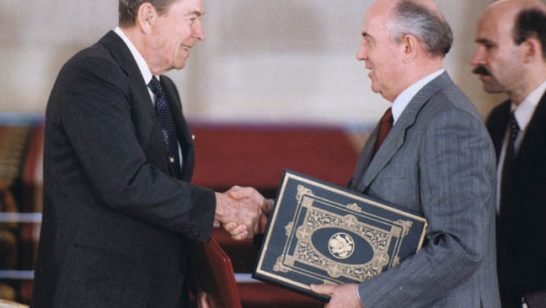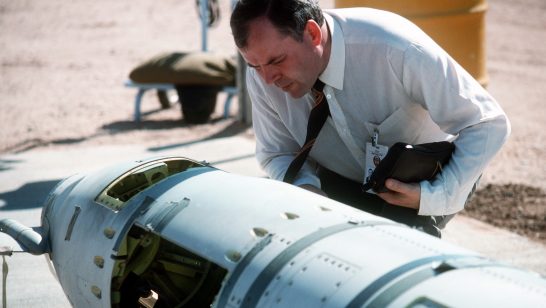
The 1987 INF Treaty was a landmark arms control and disarmament agreement that eliminated from Europe the most dangerous weapons of the era, and significantly decreased nuclear threats between NATO and the Soviet Union. For NATO, Moscow’s deployment of the SS-20 ballistic missiles, which could carry up to three warheads and hold at risk all Western European capitals, was highly destabilizing. In response, NATO decided to deploy the Pershing II ballistic missiles and fast-flying ground-launched cruise missiles (GLCMs) in Europe. Soviet Premier Mikhail Gorbachev quipped, “it was like holding a gun to our head.” Disarming these weapons was therefore in the interest of both sides, and it created favourable conditions for further arms control measures between Washington and Moscow.
Until the 2000s, Russia was mostly content with the INF Treaty but gradually started to raise concerns. Moscow’s major problem was that it only limited the US and Russia while third parties were allowed to deploy land-based missiles with a range of 500-5,500km. Instead of officially withdrawing from the treaty, Moscow started to develop a GLCM, which according to the US was flight tested within the INF range, and constituted a direct violation of the treaty provisions. Washington officially accused Russia of violating the INF Treaty in 2014. Moscow still denies that it has ever tested the system in the range of the INF Treaty.
At the same time, Russia’s decision to develop, test, and later, deploy this new system did not bring a fundamental change in the threat environment vis-à-vis the Alliance. Although the withdrawal of INF missiles from Europe eliminated a class of weapons specifically designed to hold NATO allies at risk, the nuclear threat from Moscow did not disappear. Russian strategic bombers or ICBMs can deliver nuclear warheads at shorter ranges, meaning that the new GLCM cannot threaten any new target that has not already been within the range of Russian nuclear forces.
Allies have been sceptical about the Russian violation as the US only shared limited information on evidence to support their claims. Over three years the system in question was not publicly identified, which made it difficult to debate the consequences of the alleged violation. European allies, in general, were silent on the issue. There was no concentrated pressure to bring Russia back into compliance, and there was no public or official debate about the potential effects of the violation for the European security architecture. The James Martin Center for Non-proliferation Studies conducted field research in the so-called ‘frontline states’ of Europe in December 2015, and found that government officials had very limited knowledge about the issue; had no specific opinion about what the Alliance should do to mitigate the risks of the new Russian GLCM capability; or how to bring Russia back into compliance. The German government held the first and only serious debate about the INF Treaty violation in 2018.
European allies, therefore, are very late to the debate, and they missed an important opportunity to save the INF Treaty. When President Trump announced on October 22 that the US intends to withdraw from the Treaty, European allies (especially those in the West) reacted with harsh criticism, in strong contrast to their silence over the violation itself. Over the past four years, apart from the inclusion of a paragraph in NATO communiqués that urged a diplomatic solution to the INF crisis, none of them raised the issue with Russia in bilateral meetings, or showed any serious concern about the future of the agreement. This will not help them convince Washington to stay in the treaty. It also seems to be too late to exercise a concentrated pressure on Russia to come back into compliance.
The INF Treaty remains the bedrock of European security, and withdrawing from it is a mistake. The responsibility, however, rests first and foremost on Russia for the violation. Europeans are to be blamed for not taking the issue seriously enough from the beginning, while the US is responsible for not exhausting all diplomatic and military measures before withdrawing from the agreement. There are a number of INF compliant steps that could have changed Moscow’s mind – these include increasing strategic bomber patrols in Europe, boosting missile defence capabilities, developing cruise missile defence capabilities, pre-positioning (additional) assets in Eastern Europe, and/or increasing INF compliant offensive nuclear capabilities in Europe. The US also failed to consult with its allies on a concerted effort towards Russia. Washington initially did not share much information about the violation, and the Trump administration later did not discuss the violation directly with its allies, and failed to notify them before the October announcement.
The decision to withdraw from the INF Treaty gives Russia a free pass to deploy its GLCM capability, and put the blame on the US for the demise of the agreement. Meanwhile, it would take Washington at least 7-9 years to develop, test, and deploy a new ground-based intermediate range missile system. In addition, the new system would cost the kind of money that the US does not currently possess given their ongoing and planned nuclear modernisation programmes. Moreover, it is almost impossible to conceive that NATO could come to a consensus about the re-deployment of these weapons in Europe, back in the 1980s, the Pershing deployment almost “broke” the Alliance, and it is highly unlikely to pass easily today.
The fall of the INF Treaty is primarily the result of the Russian violation, but European allies and the US are also responsible for its demise. Europe woke up too late and missed a chance to pressure Russia, while Washington did not exhaust every diplomatic and military option before deciding to withdraw from the agreement. In the current political environment, when the President and his top advisors have already made up their minds about the Treaty, it is not likely that they will reverse their decision. Europe, however, should make sure that there will not be a new arms race on the continent. It should take a leading role as mediator in the diplomatic efforts to negotiate a more modern and better agreement, with the involvement of third parties like China. It will also be essential to develop cruise missile defence and other military capabilities to deny Russia any military advantage it might hope from the deployment of its new GLCM. Withdrawal from the INF, and the way the Trump administration announced it, undermined alliance solidarity but a unified military response will require strong coordination between Washington and Brussels.
The opinions articulated above also do not necessarily reflect the position of the European Leadership Network or any of its members. The ELN’s aim is to encourage debates that will help develop Europe’s capacity to address pressing foreign, defence, and security challenge.



